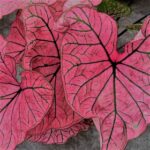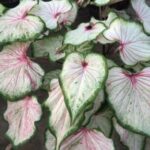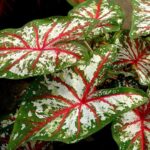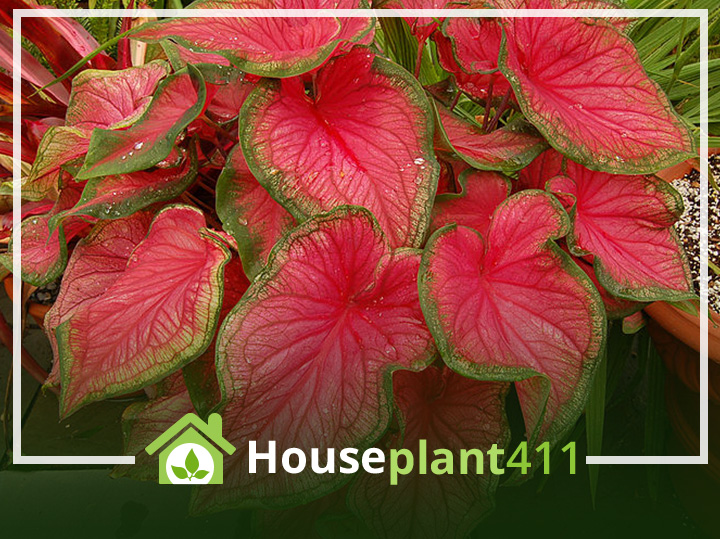About
A Caladium, or Elephant Ear plant, a member of the the Araceae family, is a tuberous, rooted perennial that originally came from South America. It is closely related to an Alocasia, whose common name is also Elephant Ear plant. All plants in the Araceae family, including the diffenbachia and philodendron, contain calcium oxalate crystals and are extremely poisonous. Caladium plants, whether indoors or outdoors, look beautiful from late spring until early fall and then die back and become dormant until early spring.
Caladium Description
Caladiums are bulb plants grown for their large, paper-thin, arrow-shaped, colorful leaves that are often more spectacular than many flowers. The most popular indoor varieties are the “fancy-leafed” and “lance-leafed” types. The leaves, some as long as 24 inches, have marbled, spotted, or veined patterns in red, pink, white, and green.
Popular Caladium Varieties




C. Spring Fling C. Pearl Blush C. Autumn Beauty C. Tapestry
Quick Care Tips
A caladium needs high humidity to keep leaves from curling and turning brown
Warm temperatures above 70° (if possible) and never below 60° during the growing season
Likes to be watered with tea
Conclusion
A caladium will go dormant and look like it is dying in the early fall. Do not throw it out. Cut the foliage back to the soil line and put the plant in a dark, cool location for several months. Water every 4-6 weeks. Once the weather warms up and the days are longer, move your caladium back to its original bright location. The beautiful ornamental foliage makes the extra care required to grow and then re-grow a caladium plant each year well worth it. These vividly colored plants are poisonous and must be kept away from pets and children. Read more about common houseplants that may be dangerous in my book Don’t Feed Me to Your Cat: A Guide to Poisonous Houseplants.
Plant Care
Light
A caladium plant requires very bright indirect light. Keep a caladium plant out of the direct sun to prevent leaf burn.
Water
The soil of a caladium plant should be moist but never soggy during the growing season. As the leaves start to die in the early fall and the caladium plant goes into its resting/dormant period, gradually reduce the water to about once every 4-6 weeks.
Fertilizer
Fertilize a caladium plant every two weeks when it is actively growing with a water-soluble plant food, high in nitrogen, diluted to at 1/2 the recommended strength. Always dilute the plant food you are giving a caladium plant or the salt in the fertilizer will burn the leaves.
Temperature
A caladium plant likes warm temperatures between 70°-85°F (21.1°-29.4°C) with as little fluctuation in temperature as possible. During the five or so months when a caladium plant is dormant, the temperature should be cooler but never below 55°F (12.8°C).
Humidity
The main reason a caladium plant gets brown or curling leaves, is lack of sufficient humidity. There are several ways to increase the humidity around your caladium plant. You can set the plant on a bed of wet gravel or pebbles. Be sure the caladium plant is sitting on the pebbles and not in the water. Place a small humidifier in the room near your caladium plant. Group several houseplants near each other to create a mini greenhouse effect which increases the humidity in the room.
Flowering
The flowers on a caladium plant are inconspicuous. The leaves are the beautiful part of a caladium plant.
Pests
The colorful leaves of a caladium plants attract mealy bugs, spider mites, and aphids. Gently wash off any pests you see on the delicate leaves with warm soapy water. If the problem persists, spray the caladium plant with Neem Oil.
Diseases
The high humidity a caladium plant requires can encourage fungal diseases such as fusarium and pythium and bacterial diseases such as leaf spot. Providing good air circulation and keeping the leaves of a caladium plant dry, helps prevent diseases. Use Neem Oil or a commercial fungicide that can be mixed with the soil to treat these fungal and bacterial diseases.
Soil
A caladium plant likes a slightly acidic, fast-draining soil. Once a month water your caladium plant with leftover tea or a very dilute solution of water and vinegar.
Pot Size
Plant caladium plant tubers in a 4″-6″ pot that has drip holes in the bottom. Cover the tubers with 1″-2″ of soil.
Propagation
Caladiums do best when propagated in the spring after the plant has had a 5-month “rest.” Digging up and dividing the calathea plant tubers, and planting the tubers in a small pot of loose soil, is the best propagation method.
Resting Period
Caladium plants, whether indoors or outdoors, look beautiful from late spring until early fall and then die back and become dormant until early spring. In the fall, when the caladium plant leaves die, move the plant to a dry, dark, cool location. Water sparingly every six weeks. A caladium plant must “rest” and be dormant for about 5 months each year before it starts to grow again.
Poisonous Plant Info
A Caladium plant is a very poisonous plant with a #3 toxicity level.
FAQ
You can store your caladium plant tubers (bulbs) in the garage as long as the temperature stays above 55°F (12.8°C).
The brown spots on your caladium plant are probably leaf burn from the sun. These plants love bright light, but never put them in direct sun.
There are several reasons why the tips and edges of caladium plant leaves turn brown. You may be feeding it too much. Always dilute the plant food to1/2 the recommended strength or the salt in the fertilizer will burn the leaves. A caladium plant requires very high humidity and the air in our homes is often very dry. Put your caladium plant on a tray filled with water and pebbles, but be sure the plant is sitting on pebbles and not in the water. You can also try placing a small humidifier near your caladium plant.
The new leaves on your caladium plant are coming in smaller and less colorful because the plant isn’t getting enough light. Move your caladium plant to an area where it will get very bright light, but no direct sun.
If your Caladium Plant Bulbs were stored in an area that was too hot or too cold, below 55°F (12.8°C) or above 85°F (29.4°C), the bulbs might have been damaged. You may not physically see the damage on the bulb, but it does effect how well and how quickly a caladium plant grows.

